| Back Number | No.19 2005/07/06 | |||
| News | Winners of the Global 100 Eco-Tech Awards Selected |  |
||
| Pavilions | Andean Amazonian Pavilion (Global Common 2) Argentine Pavilion (Global Common 2) South Africa Pavilion (Global Common 5) |
|||
| Column | Volunteerism at EXPO 2005 | |||
|
The Japan Association for the 2005 World Exposition announced on June 16 that it had completed selecting 100 global technologies that contribute significantly to the resolution of global environmental issues and to the creation of a sustainable future for humankind and the Earth. Called the Global 100 Eco-Tech Awards (co-sponsored by the Nihon Keizai Shimbun Inc.), this is an official award program of EXPO 2005 Aichi, Japan. 236 global environmental technologies nominated by EXPO 2005 official participants (including foreign governments and international organizations), Japanese local governments and screening committee members were examined by a 13-member screening committee of experts (chaired by Dr. Jiro Kondo, professor emeritus of The University of Tokyo). The 100 selected technologies, which will not be ranked, will receive a 1 million yen cash prize each. The award ceremony will take place on September 1 in Nagoya City. |
 The breakdown of the 100 technologies was 56 from Japan and 44 from 23 overseas countries. Overseas winners were from around the world, including Europe, which is a region that is advanced in environmental technologies, as well as Eastern Europe, Asia, Africa and North, Central and South America.
The breakdown of the 100 technologies was 56 from Japan and 44 from 23 overseas countries. Overseas winners were from around the world, including Europe, which is a region that is advanced in environmental technologies, as well as Eastern Europe, Asia, Africa and North, Central and South America.The award-winning technologies can be divided into eight major fields: technology to prevent global warming and secure sustainable energy (22 technologies), technology for effective use and recycling of resources (17), technology to lead to new development for sustainable society (16), technology for preserving drinking water and water resources (12), technology for conservation and recovery of nature (12), technology to utilize forest/wood resources (9), technology to utilize biomass resources (7), and technology for countermeasure against environmental pollutant (5). Winners in the field of technology to prevent global warming and secure sustainable energy, which is one of the urgent environmental issues faced by the world, accounted for about one-fifth of the 100 awards. There were many winners in this field from universities and leading companies in Japan, including Ocean Thermal Energy Conversion being developed by Saga University, which is a method of generating electricity by utilizing the thermal difference between the ocean surface and deep water, and the Toyota Motor Corporation’s hybrid system, which combines two power sources: a gasoline engine and an electric motor. Furthermore, with 11 selected, winners from abroad also accounted for half of those selected in this field, and included technologies, such as a new type of solar cell in which the panels are in strips in order to expand the surface area that was developed by Origin Energy Solar of Australia. It was a sign that there is much interest in this field both in Japan and overseas. The field with the second highest number of award-winners was technology for effective use and recycling of resources. A wide range of technologies, such as the production of fuel oil from waste plastic developed by Shin Dae Hyun of South Korea, and Eco-Park Hartberg, a new industrial park in Austria where 20 companies on a 15-hectare site constitute a network to provide environmentally-friendly products and services to each other, received awards. |
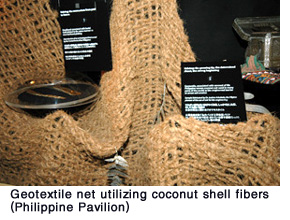 Technology for conservation and recovery of nature and technology to lead to new development for sustainable society are fields that contribute to sustainable development in developing countries. Many overseas technologies and undertakings were also selected in these two fields. One example is the use of coconut shell fibers, which are normally incinerated or disposed of as agricultural waste, as a geotextile net used to prevent landslides and protect sloping ground surfaces. The net also decomposes naturally when trees, etc. are planted on the slope, promoting reforestation. This technology developed by Dr. Justino R. Arboleda of the Philippines is currently on exhibit at the Philippine Pavilion.
Technology for conservation and recovery of nature and technology to lead to new development for sustainable society are fields that contribute to sustainable development in developing countries. Many overseas technologies and undertakings were also selected in these two fields. One example is the use of coconut shell fibers, which are normally incinerated or disposed of as agricultural waste, as a geotextile net used to prevent landslides and protect sloping ground surfaces. The net also decomposes naturally when trees, etc. are planted on the slope, promoting reforestation. This technology developed by Dr. Justino R. Arboleda of the Philippines is currently on exhibit at the Philippine Pavilion.Others award winners included a technology to monitor fires in the Brazilian rainforest (National Institute of Space Research (INPE) of Brazil), and the Kinkiizi Electricity Generating Stove (Arnold Ahimbisibwe of Uganda) which uses charcoal or firewood for cooking or boiling water while generating electricity at the same time. The 100 award-winning technologies are the fruit of the wisdom of humankind for the resolution of environmental issues. The Global 100 Eco-Tech Awards communicate such knowledge, gained through Nature’s Wisdom, and the activities of the people involved, from the EXPO 2005 venue to the world. |
![]()
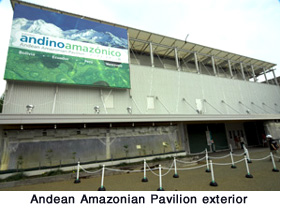 The Andean Amazonian Pavilion is the joint pavilion of four South American countries - the Bolivarian Republic of Venezuela, Republic of Bolivia, Republic of Ecuador and Republic of Peru.
The Andean Amazonian Pavilion is the joint pavilion of four South American countries - the Bolivarian Republic of Venezuela, Republic of Bolivia, Republic of Ecuador and Republic of Peru.The Bolivarian Republic of Venezuela, which faces the Caribbean, is the biggest oil power in Latin America. The Republic of Bolivia is a country with high mountain peaks whose capital is the world’s highest at an elevation of about 3,600 meters above sea level. Bolivia also has the highest rate of indigenous people in Latin America, and it is a country that still retains a traditional South American lifestyle and culture. The Republic of Ecuador is located right on the Equator and contains the Galapagos Islands, which is globally famous for its unique ecosystem that gave a hint to the theory of evolution. And last, but not least, the Republic of Peru is filled with relics of ancient Andean history, including Cuzco, the capital of the Inca Empire, and the Nazca Lines. These four countries have many commonly shared geographical areas, such as the Andes, a mountain system that runs north to south along the western edge of the South American continent. They are also all located at the upper reaches of the Amazon River, which originates in the Andean mountains, runs east and flows out into the Atlantic Ocean. |
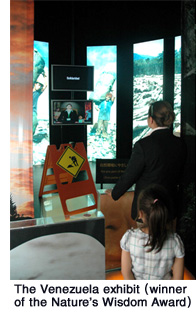 Upon entering the pavilion, the front of which is wreathed in mist as from a waterfall, visitors find themselves in a cool tunnel-like corridor. The wall on the left is covered with colorful photographs and video images of tropical fish, sharks, sea anemones and a diversity of other marine life. As visitors walk up the gently climbing slope of the corridor, they notice that the photos on the wall become those of beautiful beaches and seabirds, and they realize that they have surfaced from the sea to a beach. Further along is the world of the Amazon and its jungles where visitors meet a variety of different creatures, such as anacondas and caimans (alligator-like reptiles), as well as sloths and anteaters of the forest. The call of birds and animals can also be heard. Further up, visitors enter the high-altitude world of the Andean mountains. There, people see the refreshing scenery of the highlands, with mountains towering overhead, sheep, llamas and the indigenous people of the Andes in view.
Upon entering the pavilion, the front of which is wreathed in mist as from a waterfall, visitors find themselves in a cool tunnel-like corridor. The wall on the left is covered with colorful photographs and video images of tropical fish, sharks, sea anemones and a diversity of other marine life. As visitors walk up the gently climbing slope of the corridor, they notice that the photos on the wall become those of beautiful beaches and seabirds, and they realize that they have surfaced from the sea to a beach. Further along is the world of the Amazon and its jungles where visitors meet a variety of different creatures, such as anacondas and caimans (alligator-like reptiles), as well as sloths and anteaters of the forest. The call of birds and animals can also be heard. Further up, visitors enter the high-altitude world of the Andean mountains. There, people see the refreshing scenery of the highlands, with mountains towering overhead, sheep, llamas and the indigenous people of the Andes in view.It is a corridor full of wonder where visitors can experience, within a short span of time, the ocean deep to the height of the Andes, the diversity of nature and even the lifestyle of the people who live there. It is at the same time a comfortable and healing space for the spirit. As they come to the end of the corridor, pavilion visitors will find themselves in a wide, brightly-lit space. This is where each of the participating countries is transmitting its message to the world. The theme of the Venezuelan exhibit, which received the Gold Prize in the Nature’s Wisdom Award announced on May 26, is “People and Nature.” Scenes of magnificent nature are compared with environmental issues through hanging screens and photographs displayed in back. There is a monitor set up that shows the visitors own face above which seven words, such as harmony, love and sustainability, appear. It appeals for the visitor to ask himself/herself whether he/she is being friendly to the environment. |
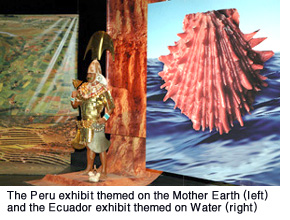 The theme of the Bolivia exhibit is “Fire.” It expresses the reality of deforestation through the ashes of deforested trees and makes an appeal to save forests. Ecuador, whose theme is “Water,” is exhibiting photographs of garbage scattered on its beaches and the Spondylus princes seashell, which have been treasured since ancient times and are said to be found only in the country. Ecuador's message of environmental conservation is being appealed in this way. Peru’s theme is “the Mother Earth.” While introducing the country’s long history and culture, including the Incan civilization, the exhibit communicates the greatness of Mother Earth that brings birth to all.
The theme of the Bolivia exhibit is “Fire.” It expresses the reality of deforestation through the ashes of deforested trees and makes an appeal to save forests. Ecuador, whose theme is “Water,” is exhibiting photographs of garbage scattered on its beaches and the Spondylus princes seashell, which have been treasured since ancient times and are said to be found only in the country. Ecuador's message of environmental conservation is being appealed in this way. Peru’s theme is “the Mother Earth.” While introducing the country’s long history and culture, including the Incan civilization, the exhibit communicates the greatness of Mother Earth that brings birth to all. |
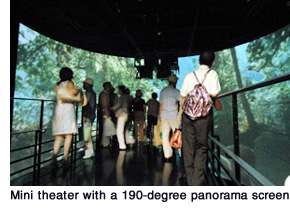 A recent addition to the Andean Amazonian Pavilion is a mini theater equipped with a 190-degree panorama screen that is 7.5 meters high and 12 meters long. The theme of the footage shown here is “The calling from the Ancestor”. The 2-minute 40-second long piece begins with a young girl listening to the call of a shaman. It expresses the beautiful natural environment of the Andean Amazonian region and the reality of the destruction of nature through moving footage and audio, appealing the need for people to join hands to undertake environmental protection. At times, the panoramic screen gives audiences the illusion of rising in the air or running swiftly through a forest. It is a theater where visitors will also be able to experience such wondrous sensations.
A recent addition to the Andean Amazonian Pavilion is a mini theater equipped with a 190-degree panorama screen that is 7.5 meters high and 12 meters long. The theme of the footage shown here is “The calling from the Ancestor”. The 2-minute 40-second long piece begins with a young girl listening to the call of a shaman. It expresses the beautiful natural environment of the Andean Amazonian region and the reality of the destruction of nature through moving footage and audio, appealing the need for people to join hands to undertake environmental protection. At times, the panoramic screen gives audiences the illusion of rising in the air or running swiftly through a forest. It is a theater where visitors will also be able to experience such wondrous sensations.The Andean Amazonian Pavilion is also making preparations to set up an Internet link between Latin America and Japan so that the people of these two regions will be able to communicate in real-time at the pavilion. This ever-evolving joint pavilion is one that you will want to keep your eyes on. |
 The climate and landscape of the Argentine Republic - a vast country in South America stretching north to south, from the vicinity of the tropic of Capricorn to a portion of Antarctica - are quite diverse. The exhibition theme of this nation blessed by its beautiful natural surroundings is “Nature’s Force.” It is in Argentina that you will find Mount Aconcagua, the highest peak in South America; the dynamic Iguazu Falls, which suddenly appears in the jungle; the vast Pampas plains of the central region; and the giant glaciers of Patagonia. The Argentine Pavilion introduces the characteristic natural beauty of each region and people’s lifestyles through photographs, maps and video.
The climate and landscape of the Argentine Republic - a vast country in South America stretching north to south, from the vicinity of the tropic of Capricorn to a portion of Antarctica - are quite diverse. The exhibition theme of this nation blessed by its beautiful natural surroundings is “Nature’s Force.” It is in Argentina that you will find Mount Aconcagua, the highest peak in South America; the dynamic Iguazu Falls, which suddenly appears in the jungle; the vast Pampas plains of the central region; and the giant glaciers of Patagonia. The Argentine Pavilion introduces the characteristic natural beauty of each region and people’s lifestyles through photographs, maps and video.Argentina is also a multiethnic country, with an indigenous population that includes the Guaranies people and those of immigrant origin, primarily from European countries such as Spain and Italy, who began arriving since the end of the 19th century. The diverse cultures brought to the country by such immigrants gradually fused to form a culture unique to Argentina. One such example is the Argentine tango. Perhaps the most passionate of couple dancing, the Argentine tango was born in the late 19th century in Buenos Aires as immigrants’ expression of nostalgia for their home country mixed with gaucho's guitar songs. A tango show, performed by professional dancers, is the most exciting attraction of the Argentine Pavilion. It is performed every day, on the hour, between 10am and 8pm. Audiences are mesmerized by the perfect yet dramatic harmony of movement of the dancers in close contact, as the performers stare into each other’s eyes and express themselves to the emotional melodies played on a bandoneon. |
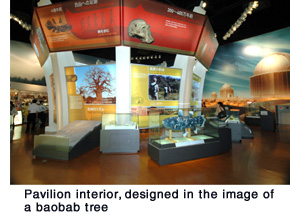 The theme of the South Africa Pavilion is “The Rhythm of Life.” Here, you can trace the history of South Africa, from “Eve’s Footprints,” which is a cast of the oldest known footprints of anatomically modern humans on Earth that is at least 80,000 years old, to “Long Walk to Freedom” by former President Nelson Mandela and the realization of democracy in South Africa in 1994.
The theme of the South Africa Pavilion is “The Rhythm of Life.” Here, you can trace the history of South Africa, from “Eve’s Footprints,” which is a cast of the oldest known footprints of anatomically modern humans on Earth that is at least 80,000 years old, to “Long Walk to Freedom” by former President Nelson Mandela and the realization of democracy in South Africa in 1994.There are many precious ancient anthropological assets on display at the pavilion, including Mrs. Ples, the fossilized skull of an Australopithecus africanus that dates back some 2.5 million years. Mrs. Ples was discovered in the Sterkfontein Caves in the World Heritage Site (Fossil Hominid Sites of Sterkfontein, Swartkrans, Kromdraai, and Environs) otherwise known as the Cradle of Humankind. Another must-see is the full-size specimen of a coelacanth, the 400 million year old “living fossil.” Once thought extinct, this fish was discovered off the coast of South Africa in 1938. The exhibit includes interesting footage, including valuable records of the discovery of the coelacanth as well as monitoring activities aimed at its protection, which is shown in an enclosed area at the center of the pavilion. The pavilion showcases how South Africa, which overcame hardships and developed into a country that enjoys peaceful prosperity, is endeavoring to contribute to the development of an environmentally sustainable world in which a multitude of cultures coexist. |
![]()
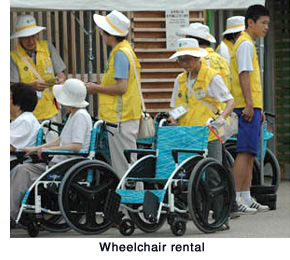 When visitors enter the gates of EXPO 2005 Aichi, Japan, one of the first things they will notice are people wearing yellow vest uniforms, greeting people with smiles on their faces, distributing venue maps, and so on. The people renting out wheelchairs and baby strollers near the gates, kindheartedly helping visitors figure out which of the rubbish bins - there are nine types separated by waste category - they should dispose their garbage in, or offering directions in front of a venue guide map are all wearing this yellow vest. They are all volunteer workers.
When visitors enter the gates of EXPO 2005 Aichi, Japan, one of the first things they will notice are people wearing yellow vest uniforms, greeting people with smiles on their faces, distributing venue maps, and so on. The people renting out wheelchairs and baby strollers near the gates, kindheartedly helping visitors figure out which of the rubbish bins - there are nine types separated by waste category - they should dispose their garbage in, or offering directions in front of a venue guide map are all wearing this yellow vest. They are all volunteer workers.There are about 29,000 people registered as EXPO 2005 volunteers, 60 percent of whom, we are told, are experiencing volunteerism for the first time through this EXPO. During the 185-day EXPO, those registered as volunteers are asked to offer their services for five days or more, while those 500 people in leadership positions are to participate for 20 days or more. The original target was to have a cumulative total of 100,000 volunteers participate. However, now that EXPO 2005 is more than halfway through, it looks as if this target will be achieved with ease. That is how enthusiastically people are participating in this EXPO as volunteers. There are of course many volunteers from Aichi Prefecture where EXPO 2005 is taking place, but people from 25 other prefectures and city governments around Japan are also taking part as volunteers. It includes even foreign residents of Japan. Weekdays see the participation of many homemakers, whose children have grown up, as well as retirees. Weekends, however, also see many students and young company workers that are utilizing their day off for volunteerism. Volunteers work in a wide-variety of activities. Besides those mentioned earlier, they also help escort wheelchair and other disabled visitors around the venue or work as Kids Eco Tour guides, introducing the environmentally-conscious facilities, etc. of EXPO 2005 to children and other visitors. Volunteers work every day from 9:00am to 10:00pm in three shifts (4-and-a-half hours each). The characteristic of the EXPO 2005 volunteer system is that the overall management and operation of this system is conducted by the EXPO 2005 Volunteer Center, an organization separate from the Japan Association for the 2005 World Exposition which operates the EXPO itself. Since its establishment in December 2002, the Volunteer Center set up five committees, each of which listens to the opinions and ideas of citizens, who are in a position more closer to EXPO visitors, and has striven to realize them. For example, the Kids Eco Tour was originally a proposal made by a volunteer participating in one of the committees. |
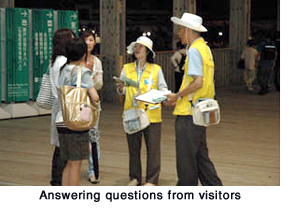 Volunteers first sign in at one of three Volunteer Centers, at the West, North or Seto Gate. After being briefed, they begin their volunteer activity for the day according to that communicated to them by their leader. One of the important tasks is to check the variety of hand-written information displayed at Centers' bulletin boards on self-sticking notepaper. It includes information regarding questions asked by visitors that day, such as “Where can I buy an ice-cream cone?” and the appropriate response, items to note when guiding a disabled person to a parking lot, and so on. They give you a sense of the warm consideration that volunteers are taking towards EXPO visitors.
Volunteers first sign in at one of three Volunteer Centers, at the West, North or Seto Gate. After being briefed, they begin their volunteer activity for the day according to that communicated to them by their leader. One of the important tasks is to check the variety of hand-written information displayed at Centers' bulletin boards on self-sticking notepaper. It includes information regarding questions asked by visitors that day, such as “Where can I buy an ice-cream cone?” and the appropriate response, items to note when guiding a disabled person to a parking lot, and so on. They give you a sense of the warm consideration that volunteers are taking towards EXPO visitors. |
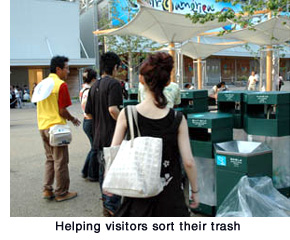 A self-employed man, who left his work early that day and was offering guidance to visitors in sorting their trash said, “I was born the year that Expo ’70 was held in Osaka. This is the first world exposition to be held in Japan in 35 years, so I didn’t want to just come and see it. I wanted to participate.”
A self-employed man, who left his work early that day and was offering guidance to visitors in sorting their trash said, “I was born the year that Expo ’70 was held in Osaka. This is the first world exposition to be held in Japan in 35 years, so I didn’t want to just come and see it. I wanted to participate.”EXPO 2005 Aichi, Japan is the first international exposition to be held in the 21st century. It is the first world exposition with the participation not only of governments and corporations but also citizens. Volunteerism is one of the ways in which citizens are participating, and the experiences of the cumulative total of 100,000 people taking part in EXPO 2005 as volunteers will surely play a part in the creation of a certain future where nature and man will coexist in harmony. |
| EXPO 2005 AICHI, JAPAN Newsletter | |
| To read past issues:Back Number | |
| Editor/Publisher: Japan Association for
the 2005 World Exposition Head Office: 1533-1 Ibaragabasama, Nagakute-cho Aichi 480-1101 Japan Nagoya Office: Nagoya Daiya II Bldg 4F, 3-15-1 Meieki Nakamura-ku, Nagoya, Aichi 450-0002 Japan Tokyo Office: Iino Bldg 8F, 2-1-1 Uchisaiwai-cho Chiyoda-ku, Tokyo 100-0011 Japan |
 |
© Japan Association for the 2005 World Exposition
